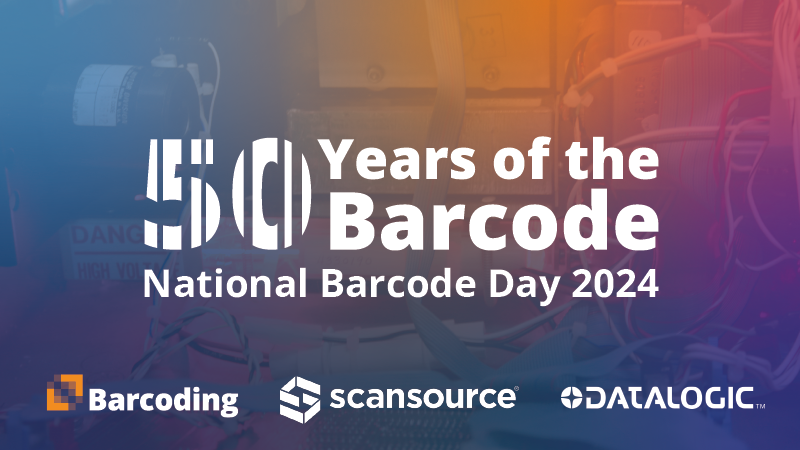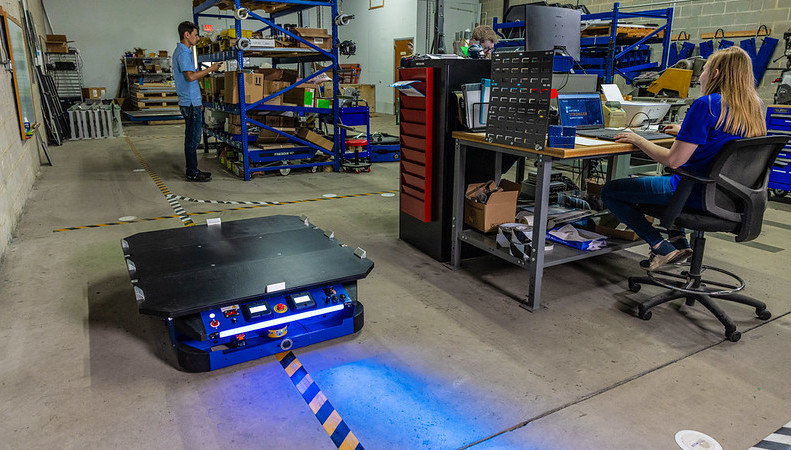As the #SupplyChainGeeks among us prepare to hit “submit” on 2023 and launch a fresh window into 2024, we’re pausing to look back on the supply chain trends and insights that shaped an exciting year.
Unlike the pandemic-influenced disruptions of previous years, this year’s biggest influences include new applications of artificial intelligence. AI brings a whole new dimension of potential to data capture and analysis, automation, and the technologies transforming industries everywhere.
We’re looking ahead toward an era in which technology does much more than solve problems; AI, machine learning, and automation have the potential to reshape the competitive landscape by fundamentally changing the way supply chains operate.
Amidst all the fast-moving change, our experts have been keeping a pulse on the best of the year’s innovations—and on the solutions that most effectively help our customers be more efficient, accurate, and connected.
In the true spirit of our #SupplyChainGeeks, we offer the 10 Geek Speak Blog posts from 2023 that we think capture the essence of the year that was.
1. How is Automation Transforming & Improving Warehouse Operations?
Warehouse operators everywhere are facing a convergence of challenges: a tough labor market, high real estate costs, unpredictable supply chains, and constantly changing consumer behaviors. All together, it adds up to a whole different industry these days—and that demands a transformation. Automation can help improve key performance indicators like speed, efficiency, accuracy, safety, and costs in virtually every corner of warehouse operations.
And it’s not just physical automation involving IoT-connected devices, sensors, cameras, and robotics. Warehouse operators are achieving new levels of visibility, efficiency, and cost savings by automating digital processes, too. All together, these capabilities are revolutionizing the modern warehouse.
This transformation not only optimizes operational efficiency and customer satisfaction but also enhances the work lives of employees by taking over tedious, repetitive, and risky tasks, thereby creating safer and more satisfying work environments
2. How AGVs Help Manufacturers Tackle These 6 Major Challenges & Grow
Speaking of automation…automated guided vehicles (AGVs) have been safely and predictably moving materials and products for decades—and today’s AGVs are raising the bar. You’ll find them eliminating the need for workers to push or carry heavy loads over long distances, and keeping production lines supplied and running.
From reducing operational costs and supporting continuous operations to enhancing employee safety, AGVs help manufacturers address challenges like limited capital, labor shortages, process inefficiencies, employee skills gaps, increasing technology demands, and even cybersecurity threats. Best of all, with robots-as-a-service and rental options, AGVs offer a great entry point for physical automation.
3. How to Improve Inventory Management & More with RFID Location Tracking
Like AGVs, RFID technology has been around for decades and these days, it’s proving its value in inventory management applications. As supply chain challenges and consumer preferences collided in the wake of the pandemic, RAIN RFID introduced all new levels of real-time inventory visibility. And that visibility has been transformational for retailers, distributors, and third-party logistics providers (3PLs).
How big a deal is the improvement? Big enough for retail giants to require suppliers to source-tag products with RFID-enabled tags or labels before they arrive at DCs.
When you read this article, you’ll quickly understand that RFID’s operational benefits don’t end with inventory visibility, serialization, and real-time product tracking. It’s helping optimize picking and replenishment, reduce stock discrepancies, and track condition of perishables. It’s improving accuracy and reducing costs. It’s speeding up inventory counts. And the improved data accuracy is supporting better business insights and decision-making.
4. How GS1 Standards & Data Capture Help QSRs & Grocers Meet FSMA 204 Rules
It’s coming: Compliance with FDA’s recent changes to the Food Safety Modernization Act’s Section 204 (FSMA 204) starts January 2026. Stakeholders at producers, distributors, grocers, and quick-serve restaurants are going to see changes to their planning and reporting responsibilities for tracking and tracing certain foods through the supply chain.
The article digs into the details of new regulations and what’s needed to comply, and how data capture technologies like barcodes and RFID streamline compliance and facilitate communication between stakeholder-partners. But the beating heart of vendor-partner collaboration across supply chains is data standardization—and that’s where GS1 Standards change the game.
By providing a common language for data capture, including unique identifiers like Global Trade Item Numbers (GTIN) and Serial Shipping Container Codes (SSCC), GS1 Standards enhance traceability, efficiency, and compliance, and allow stakeholders to manage data related to shipment verification, inventory management, product ordering, and waste tracking more effectively.
5. 11 IT Asset Maintenance Best Practices to Optimize Productivity & Savings
How can routine asset maintenance become a strategic advantage? By optimizing productivity and preventing the need for more costly services, repairs, or replacement. And that’s why it’s so important to take a systematic approach that incorporates proven best practices.
This starts with establishing a centralized inventory of IT assets, and tagging and tracking all those assets to provide visibility into locations, conditions, statuses, and much more. An inventory and asset management solution like IntelliTrack® streamlines every process, from purchase planning to end-of-lifecycle disposition tracking.
Meticulously managed asset maintenance ensures efficient operations, minimizes downtime, and maximizes technology infrastructure ROI. And getting it right is a lot less painful with the help of a strategic partner.
6. How Can Care of Patient Belongings & Valuables Build Trust & Satisfaction?
Patient care is the core focus in the healthcare sector, but it’s important not to overlook the care and tracking of patient belongings and valuables. Improving patient belongings tracking can help providers build trust and satisfaction by extending care for patients beyond the boundaries of medical treatment.
Trust is a key component of the patient-provider relationship, affecting treatment satisfaction, adherence to medical advice, and the likelihood of a patient recommending a provider. Misplaced belongings like hearing aids, glasses, jewelry, and mobile phones can cause stress and add to costs for patients and providers.
IntelliTrack Patient Belongings Tracking (PBT) combines mobile computing, scannable barcodes, digital photos, and automation to streamline and simplify documentation and safekeeping of patient belongings. That reduces human error, mitigates risk, and enables healthcare staff to focus on patient care.
7. 9 Game-Changing Ways Mobile UX Matters to Warehouse Workers
Can a great mobile user experience (UX) transform warehouse work? Absolutely. And it’s not just about attracting and retaining younger generations of digital-native workers. Optimizing mobile UX is helping warehouse operations improve worker safety, engagement, productivity, and accuracy.
And the benefits don’t stop there. Find out how mobility can streamline worker onboarding and training, support continuous improvement, and even expand the accessibility of warehouse jobs to workers of diverse abilities, fostering a more diverse and inclusive workplace.
8. Level Up Your Warehouse! 5 Easy Gamification Ideas to Boost Performance
Employees in any industry can appreciate ways to have a little more fun on the job, and with warehouse gamification, fun and performance improvements go hand in hand. Thoughtful use of gamification can enhance productivity, efficiency, and accuracy in warehouse operations. This article introduces five easy yet effective ways to integrate game mechanics like points, levels, leaderboards, and badges into work tasks.
Integrating gamification strategies with technology like wearable devices, voice-enabled systems, and augmented reality can level-up the day-to-day experience of warehouse workers. The key is to balance competition with collaboration, and get lots of employee feedback to ensure the fun and games help workers get the job done.
9. The Future is Now: An Insider’s Look at Mobile Computing’s Impact on Efficiency
Mobile devices have evolved from simple, task-focused tools to complex systems that are integral to warehousing and manufacturing operations. And as they’ve evolved, they’ve also revolutionized the way work is done.
Today, advancements in mobile computing bridge the gap between humans and automated systems. Mobility’s inherent flexibility enables customized solutions to meet widely divergent operational needs as businesses modernize. But increasing use of mobile computing can bring challenges, particularly in the areas of user experience and securing devices and data.
10. How to Make the Most of Data Insights and an Evolving Mobile Workforce
This article is a critical read for anyone looking to leverage data for strategic decisions in a rapidly changing business environment.
In November, Barcoding hosted an executive summit focused on the challenges of attracting and retaining employees while optimizing worker productivity. Key discussions revolved around transforming enterprise data into actionable insights across multiple industry sectors.
The opportunity to listen and hear firsthand from industry leaders was incredibly valuable for our team. Highlights included conversations about mobility’s role in improving the employee experience, how employers can use automation to enable their people to do more creative and meaningful work, and mining enterprise data for insights that can translate into customer experience improvements and faster, better-informed business decisions.
Looking Ahead to 2024: What’s on the Supply Chain Horizon?
As we look toward 2024, the integration of AI and machine learning in supply chain operations is anticipated to be a major trend. Advances in these technologies are set to transform businesses’ ability to mine enterprise data for actionable insights into consumer behavior, demand trends, vendor issues, and much more.
Machine learning algorithms have great potential to enhance inventory management by reducing waste and improving efficiency. And AI already plays a key role in route optimization for logistics. These advancements are just the tip of the iceberg, and they point to a brighter supply chain management future for businesses of all sizes, in virtually all sectors.
Learn more about leveling up your game in the new year with tech advancements and new solutions in our Warehouse Gamification guide, below!







